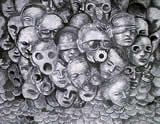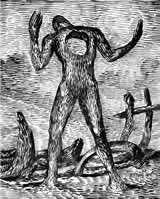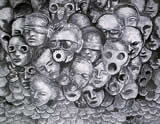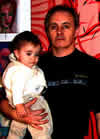

|
Warning: some of the images on this site are disturbing, but much less disturbing than actual war.
THE WAR ROOM….you can't look away. INTRODUCTION TO A WORK-IN-PROGRESS Welcome to The War Room Project, the website for an anti-war art installation by William T. Ayton. The site will be updated regularly; visit Gallery One, Gallery Two and News for new art, project development and progress reports. You can also email us here. WHY CREATE THE WAR ROOM? The
War Room seeks to: WHAT IS THE WAR ROOM PROJECT? The War Room installation is constructed of four wall-sized panels depicting fundamental aspects of war: warriors, victims, witnesses, and aftermath. Unlike conventional war rooms designed to devise military strategy, Ayton’s War Room forces a provocative confrontation with the brutal realities and consequences of war. Inside the almost claustrophobic space, intense images engulf the viewer compelling us to face fundamental questions of where we each stand in the war room. You can’t look away. We identify with the powerful and ravaged figures portrayed in the war room; we see ourselves as the warriors, victims, and witnesses; and we recognize the bleak desolation and alienation of the aftermath that we all experience in our daily struggle to make sense of these turbulent times. Currently, several possible venues for the installation are being considered, as well as possible exhibitions of The War Room prototype and related art. The exhibition schedule of events will be posted as itinerary is confirmed. Meanwhile, initial studies and related art has been shown at the "War and Peace: Artists' Voices" Exhibition at Gallery 218 in Milwaukie, WI. and at the "Art of War" online gallery at www.wnyc.com. Preliminary studies (pencil sketches) for the panels can be seen online in "the room." "Gallery one, related works" features more detailed sketches and recent works by Ayton with references and echos to The War Room panels. "Gallery two, precursor works" presents images of Ayton's art from previous years dealing with related topics: human rights, Hiroshima, war and peace. In this context, The War Room stems from a larger body of work by Ayton addressing global themes. As the art work for the project continues to be developed, it will be posted on this site. WHO WILL THE WAR ROOM REACH?
While the installation intends to reach a broad, public audience
primarily in urban, international centers, the War Room
Project website will reach viewers anywhere in the world with online
access. In the post-9/11 climate, the American public has been inundated
with images of nationalism. At the same time, in the name of patriotism
and “homeland defense,” unprecedented limits on free
speech threaten to curtail and inhibit artistic expression, especially
on vital policy issues such as war and peace, national security
and civil liberty, racism and tolerance. As a result, the media-numbed
public has been effectively sheltered from provocative art addressing
fundamental questions. The War Room intends to
puncture this invisible shield by reaching out to audiences and
taking a stand for peace and tolerance through art. ARTIST'S STATEMENT When the tapestry of Picasso's Guernica was covered up for a Colin Powell speech at the U.N. (February 2003), I knew I had to do something. The War Room project is my response. The project is intended as a thoughtful & meditative consideration of the subject of war. After millennia of human existence, it seems we can't get past the urge to solve our problems by wantonly destroying each other. This to me, far from being a noble achievement of humankind, conversely shows us to be little more than savages, despite whatever technological, medical, philosophical, artistic and other "advances" we have made. At our root, we still revel in killing one another and wrecking our fragile planet in the process. That's simply not good enough, and it has to stop. Peace, William T. Ayton, 2003
|





